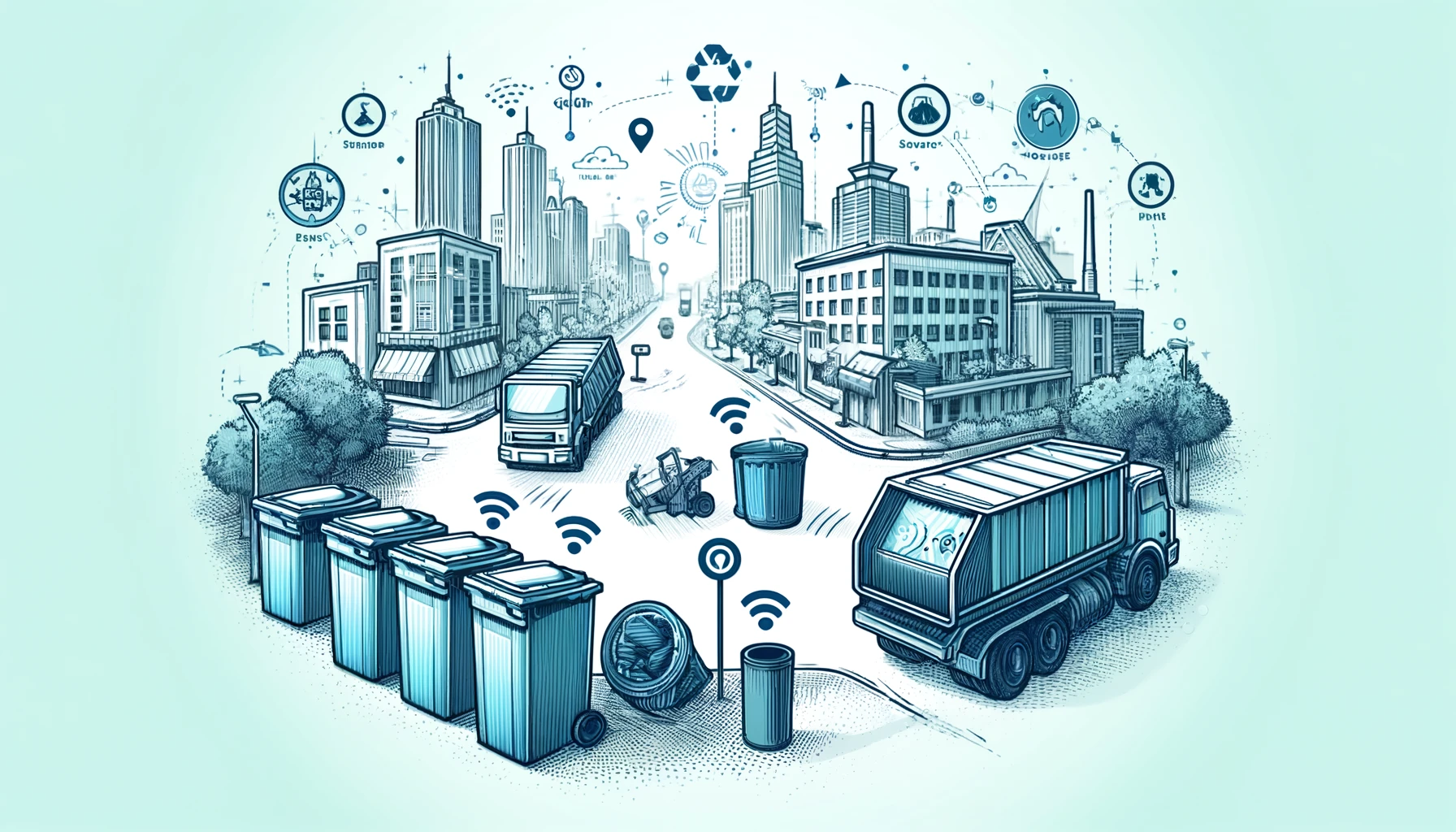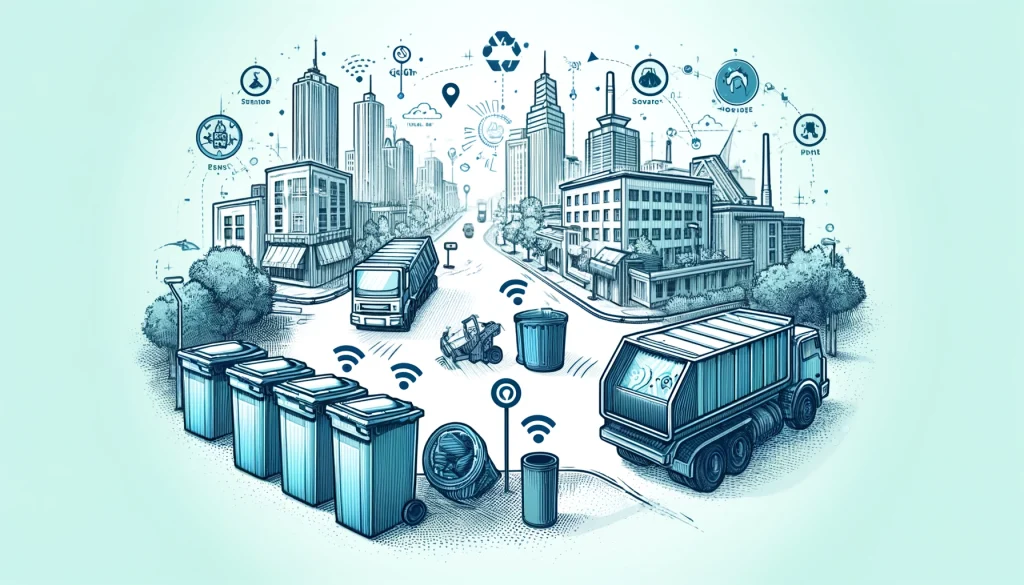Waste & material traceability solution for sustainable facilities

The Internet of Things (IoT) is fundamentally changing how we approach waste management, creating smarter, more efficient systems that provide unprecedented visibility and control over waste operations. As we move through 2025, IoT trends in waste management continue to evolve, bringing new capabilities that address longstanding challenges in waste collection, processing, and resource recovery. From intelligent bins that communicate fill levels to predictive analytics that optimize entire collection networks, IoT technology is unlocking new capabilities across collection, processing, and sustainability — driving down costs while improving service quality and environmental outcomes.
The integration of IoT technology in waste management represents more than just adding sensors to existing systems. It’s creating entirely new paradigms for how waste operations function, moving from reactive, schedule-based approaches to proactive, data-driven strategies that optimize resources in real-time. Traditional waste management relies heavily on fixed collection schedules and manual monitoring, leading to inefficiencies such as collecting half-empty containers or missing overflowing bins. IoT technology addresses these challenges by providing continuous monitoring and intelligent decision-making capabilities that adapt to actual conditions rather than predetermined schedules.
The economic and environmental impact of IoT adoption is significant. Many organizations report 20–40% reductions in collection costs through optimized routing and scheduling. Fuel savings translate directly to reduced emissions, while sensor data enables better planning and long-term resource allocation.
Smart bins equipped with IoT sensors represent one of the most visible and impactful trends in waste management technology. These intelligent containers continuously monitor fill levels, providing real-time data that enables dynamic collection scheduling and route optimization. Modern smart bins typically use ultrasonic sensors and weight sensors to accurately measure waste levels. Some providers in the industry are also experimenting with computer vision and advanced monitoring features. This data is transmitted wirelessly to central management systems, creating comprehensive visibility across entire waste collection networks.
IoT sensors throughout waste management systems generate vast amounts of data that enable predictive analytics capabilities. This trend is moving the industry from reactive maintenance and operations to proactive strategies that prevent problems and optimize performance. Predictive maintenance uses IoT data to monitor equipment health and predict failure points before they occur. In the industry, sensors on collection vehicles track performance indicators such as fuel usage, mileage, and component status. This information enables maintenance teams to address issues during scheduled downtime rather than dealing with unexpected breakdowns.
Collection route optimization represents another area where predictive analytics delivers significant value. By analyzing historical data, weather patterns, and real-time conditions, IoT systems can predict optimal collection schedules and routes that minimize fuel consumption while ensuring service reliability.
IoT has transformed fleet management with real-time visibility into vehicle location, performance, and status. GPS, telematics, and onboard sensors monitor everything from driver behavior to fuel consumption. This information allows dispatchers to respond immediately to changing conditions, while integration with smart bin networks ensures that trucks only visit containers that need servicing. The result is a leaner, safer, and more transparent fleet operation.
As sustainability requirements grow, environmental monitoring is becoming a priority for waste operators. IoT sensors can track emissions, noise, and even air quality around waste facilities. This data helps operators comply with regulations while minimizing their environmental footprint. Carbon footprint tracking is especially important as cities and companies work toward climate goals. By combining IoT data with operational insights, organizations can quantify their impact and provide evidence of progress to regulators and stakeholders.
The integration of waste management IoT systems with broader smart city infrastructure represents an emerging trend that creates new opportunities for efficiency and service improvement. This connectivity enables waste management to become part of comprehensive urban management systems. Smart city integration allows waste management systems to access traffic data, weather information, and other city services to optimize operations. For example, collection routes can be adjusted based on real-time traffic conditions or special events that affect accessibility.
Moreover integration with citizen engagement platforms enables residents to report issues, request services, and receive updates through mobile apps and web portals. This connectivity improves service responsiveness while reducing administrative overhead for customer service operations.
The massive amounts of data generated by IoT systems in waste management are driving advances in analytics and machine learning applications. This trend is enabling increasingly sophisticated optimization and prediction capabilities that improve operations over time. Machine learning algorithms analyze patterns in waste generation, collection efficiency, and operational performance to identify optimization opportunities. These systems can predict seasonal variations, identify anomalies, and recommend operational adjustments that improve efficiency and reduce costs.
Advanced analytics also support strategic planning by providing insights into long-term trends, capacity requirements, and infrastructure needs. This intelligence helps organizations make informed decisions about investments and operational changes.

The future of IoT in waste management promises even more sophisticated capabilities as technology continues to evolve. Edge computing will enable more processing power at the sensor level, reducing latency and enabling real-time decision-making without cloud connectivity. 5G networks will provide faster, more reliable connectivity for IoT devices, enabling new applications such as high-definition video monitoring and real-time AI processing. This enhanced connectivity will support more sophisticated monitoring and control capabilities. Blockchain integration may provide secure, transparent tracking of waste materials from generation to final processing, supporting circular economy initiatives and regulatory compliance.
The benefits of IoT are clear, but implementation comes with challenges. Cybersecurity must be prioritized as more devices connect to networks. Data management becomes increasingly complex as volumes scale, requiring infrastructure and governance. Integration with legacy systems can also pose difficulties, demanding technical expertise and careful planning.
Evreka addresses these hurdles with a cloud-based architecture that ensures secure data handling, scalable analytics, and seamless integration. Professional services support customers in deployment, ensuring IoT adoption delivers both immediate and long-term value.
Evreka’s solutions align directly with the trends shaping the future of waste management:
By aligning its platform with each of these trends, Evreka ensures that waste operators, municipalities, and producers not only meet today’s operational challenges but also prepare for the innovations shaping tomorrow’s industry.
The IoT trends shaping waste management represent unprecedented opportunities for operational improvement, cost reduction, and environmental impact. Organizations that embrace these technologies gain competitive advantages through improved efficiency, better service quality, and enhanced sustainability performance.
Evreka’s comprehensive IoT platform demonstrates how smart technology can address real-world waste management challenges while positioning organizations for future success. From smart bins and predictive analytics to fleet management and environmental monitoring, Evreka provides the integrated solutions needed to maximize IoT benefits.
The future of waste management is connected, intelligent, and data-driven. Organizations that invest in comprehensive IoT platforms like Evreka’s will be best positioned to capitalize on emerging opportunities while meeting evolving operational and regulatory requirements.
Request a demo to see how Evreka’s smart recycling solutions can improve your sustainability program and drive measurable circular economy results. Learn more about our comprehensive smart waste management solutions and explore additional success stories from our circular economy partnerships